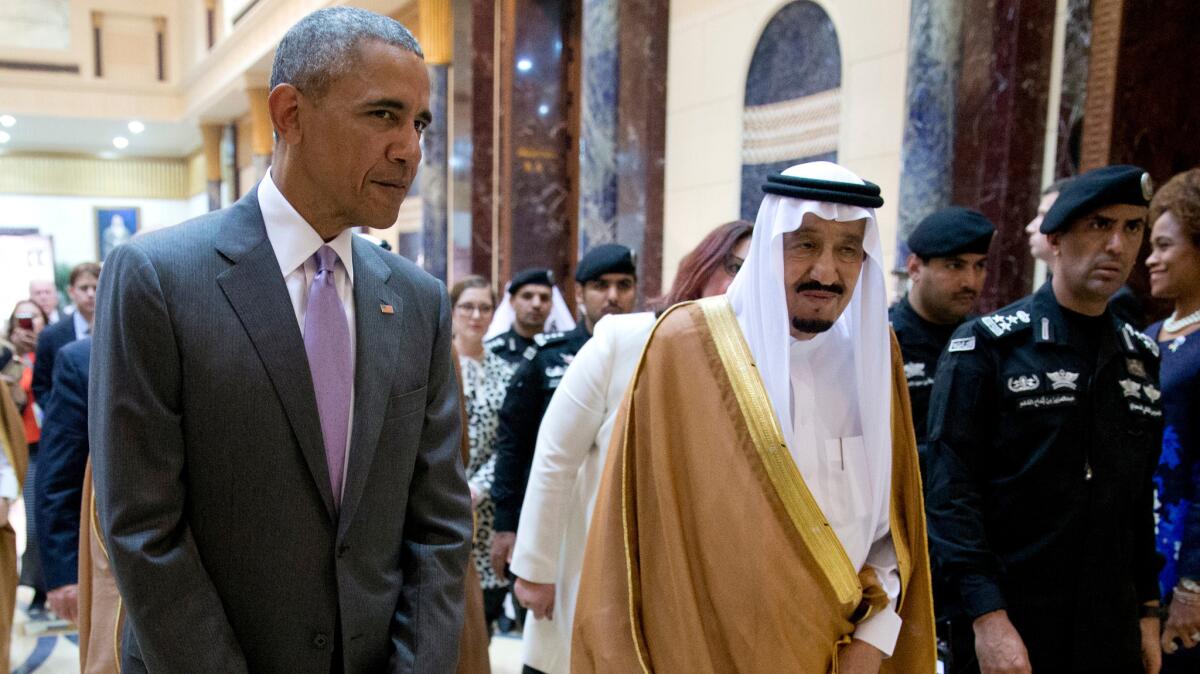Op-Ed: The Saudis can’t rein in Islamic State. They lost control of global Salafism long ago.

- Share via
Can a state be both the target of Islamist extremists and responsible for their actions? The attacks on July 4 in three Saudi Arabian cities, almost certainly perpetrated by adherents of Islamic State, have once again raised this question for drive-by analysts. They point out that the official interpretation of Islam in Saudi Arabia, which outsiders refer to as Wahhabism and Saudis refer to as Salafism, shares many elements with extremist ideology. Then they argue that Saudi efforts to proselytize Salafism played a role in the development of the global jihadist movement, and that the Saudis thus bear a special responsibility to rein in their support for Muslim institutions outside their borders and to moderate their practice of Islam at home. The implication is that if the Saudis would only change their behavior, the threat represented by the radicals would be greatly reduced.
This understanding of the relationship between the official Islam of Saudi Arabia and the contemporary Salafi jihadist movement, represented by Islamic State and Al Qaeda, misses as many important facts as it highlights.
It is undoubtedly true that Saudi Arabia, since the 1960s, has built a set of institutions and networks to spread its puritanical, narrow-minded views on appropriate religious practice, as well as intolerance of other religions or other interpretations of Islam. With the oil revolution of the 1970s, the Saudis had enormous resources to support that effort. In the 1980s, the Saudis (along with the United States) supported a campaign in Afghanistan against the Soviet Union that both they and Washington were happy to call a jihad.
At that point, the Saudis lost control of global Salafism, if they ever really had it.
Saudi Wahhabism is profoundly quietist politically. It calls on Muslims to obey their rulers, as long as those rulers implement Islam, however imperfectly, in their society. (That is not particularly surprising for a state religion.) The success of the jihad in Afghanistan, however, lent a revolutionary political content to global Salafism for some of its adherents, like Osama bin Laden, which soon became a direct threat to the Saudi regime and all other Muslim governments around the world.
What had been a largely apolitical phenomenon of Muslims emulating Saudi Wahhabism in their personal lives became, for part of the global Salafi movement, an element of their political identity. Some continued on the path of violence, joining or sympathizing with Al Qaeda and then Islamic State. Others, including activists in Saudi Arabia, eschewed violence but criticized their governments for drifting away from the “true” Islam. Still other Salafis entered the democratic political sphere, winning parliamentary seats in Kuwait, Bahrain, Egypt and elsewhere.
Salafism morphed into a religious movement with a number of political manifestations, only one of which was the blend of social conservatism and political quietism represented by the official Saudi variant.
The more immediate task is to convince those attracted to Salafism that the violent path is, as the Saudi clerics say, ‘deviant.’
This means that leaning on the Saudis to become “less Wahhabi” is unlikely to have much effect on jihadist movements like Al Qaeda and Islamic State. They and their followers look to other sources of political and doctrinal inspiration, not the official Saudi clerics. The jihadist groups draw some of their adherents from Saudi Arabia, but the vast majority of Saudi Muslims, including the vast majority of Saudi Wahhabis, reject these groups. Saudi Wahhabism can be a path toward jihadism, but it is hardly the only one. Tunisia, probably the most secular state in the Arab world and the one relative success story of the Arab Spring, has sent more jihadists to Syria than has Saudi Arabia. The Europeans and Americans attracted by the propaganda of Islamic State did not grow up in the milieu of official Saudi Wahhabism.
Global Salafism is now unmoored from its Saudi origins.
Saudi Arabia still has a role to play in the campaign against Islamic State and Al Qaeda. Much like it did against Al Qaeda in the mid-2000s, it needs to crush whatever incipient Islamic State movement exists within its borders. It needs to police the funding and recruitment networks through which radical organizations raise money and recruit manpower in the country. Saudi-American intelligence cooperation on this issue is extensive and productive, but Washington should not hesitate to call out Riyadh if it detects any slipping. The Saudis need to concentrate more of their newly active military force against Al Qaeda and Islamic State in Yemen.
The Saudis can also contribute to the ideological fight against Salafi jihadism, but not in the way most Western liberals think. The admonition for “tolerance” has much to recommend it as Saudi leaders think long term, but the more immediate task is to convince those attracted to Salafism that the violent path is, as the Saudi clerics say, “deviant.” Liberal “reforms” in Saudi Arabia are not going to convince pious Salafis that their interpretation of Islam is incorrect. Rather, the Saudis have to redouble their efforts to use the domestic and international institutions of Islam that they created and funded to convince believers that Salafi Islam itself prohibits the acts of violence perpetrated in its name.
F. Gregory Gause III is professor of International Affairs at the Bush School of Government and Public Service of Texas A&M University. He wrote about Saudi-American intelligence cooperation for the July/August issue of Foreign Affairs.
Follow the Opinion section on Twitter @latimesopinion or Facebook
More to Read
A cure for the common opinion
Get thought-provoking perspectives with our weekly newsletter.
You may occasionally receive promotional content from the Los Angeles Times.










